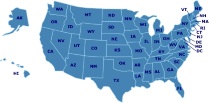Map & Globe Skills
The ability to properly read maps and globes gives you an opportunity to explore different places, people, and cultures in the real world. These resources, teaching tips, and ideas will help make it easy for your children to learn to read and understand maps and globes.
Activities & Experiments
Name That Country Game
"Dear Pen Pal, Konnichi wa! We've been to see Mt. Fuji. Name my country! Sayonara, Michiko." Challenge your group with this fast-paced geography game, created in 1992 by Educational Insights, Inc. Everyone begins at the post office. Players twirl a finely printed spinner (built into the game board itself) to select one of 60 countries. If the player can correctly identify the country's location on the board's numbered map, he or she may advance along the path to the finish. Bonus moves are won by landing on "postcard" spaces, listening to the clues on one of the 40 postcards, and correctly identifying the pen pal's country. (The sample postcard above came from Japan.) A more challenging game can be achieved by requiring players to name the country's capital; answers are provided. --Liane Thomas
Postcard Kids
Geography Postcard Kids Project started for homeschooled children around the world in October of 2002. It is intended to help enhance geographic studies by sending postcards from their local area to other postcard kids around the world.
Great States Board Game
What is the capital of NJ? Where is the Football Hall of Fame? These are just a few of the hundreds of questions players are asked as they adventure around the USA discovering state attractions and landmarks, capitals, state abbreviations, state locations and more. In order to answer the questions on the cards, players must look closely at the colorful USA map game board, becoming familiar with the geography of the country. Players must hurry to find the answers as the mechanical timer ticks. Contents: Game board, 100 Figure cards, 100 Fact cards, 100 Find cards, 1 spinner, 1 mechanical timer, and game rules. Duration of Play: 20 minutes. 2-6 players.
Teaching Tips & Ideas
Knowledge Quest
Knowledge Quest offers historical outline maps and timelines designed for the interactive study of world history and geography.
How I Teach a Large Family in a Relaxed, Classical Way: History
A look at teaching history across several grades using the classical method of education and a rotation of history every four years.
Featured Resources
As an Amazon Associate, we earn from qualifying purchases. We get commissions for purchases made through links on this site.
Visual Brainstorms
Children who love word games, logic puzzles, secret codes, mazes, and math mysteries will stretch their mental muscles with Visual Brain Storms. This set of 100 cards, each of which includes a humorous, full-color drawing, promises "the world's best brainteaser questions." The characters in the questions often have funny names (Professor Pith Bugby pops up often) or faces or dilemmas to solve. The answers and explanations are on the back of each card, along with a related bonus question. Many of...
Homeschooling: A Patchwork of Days: Share a Day With 30 Homeschooling Families
From a bedroom community in Nebraska to a farm in Vermont, from families who rely on workbooks to those who have sworn them off, this in-depth examination of the lives of homeschoolers covers a wide range of people and methods. When author Nancy Lande started homeschooling more than 10 years ago, this is the book she wanted that didn't exist. What better way to create your homeschool than reading about others and picking and choosing the styles that appeal to you? Lande has corralled a variety o...
Learning Styles: Reaching Everyone God Gave You to Teach
This book offers helpful and practical strategies about the different ways that kids acquire information and learn, and then use that knowledge. Kids' behavior is often tied to a particular learning style and understanding that fact will help parents respond to their child in ways that decrease frustration and increase success, especially in a homeschooling environment.
Classical Education & The Home School
Classical education is an idea whose time has come again. When parents see the failures of modern education, they look for better solutions and classical education is one that has been tested in the past and found to be good. For the Christian home educator, the classical education model is a path to joy and success.
Homeschooling Essentials: A Practical Guide to Getting Started
If you're ready to begin homeschooling, then the experiences of others can offer valuable help and encouragement as you jump into this new adventure. This practical guide answers common questions, helps you navigate the legalities of homeschooling, talks about the practical side of homeschooling and different methods, offers resources and gives advice about high school.







